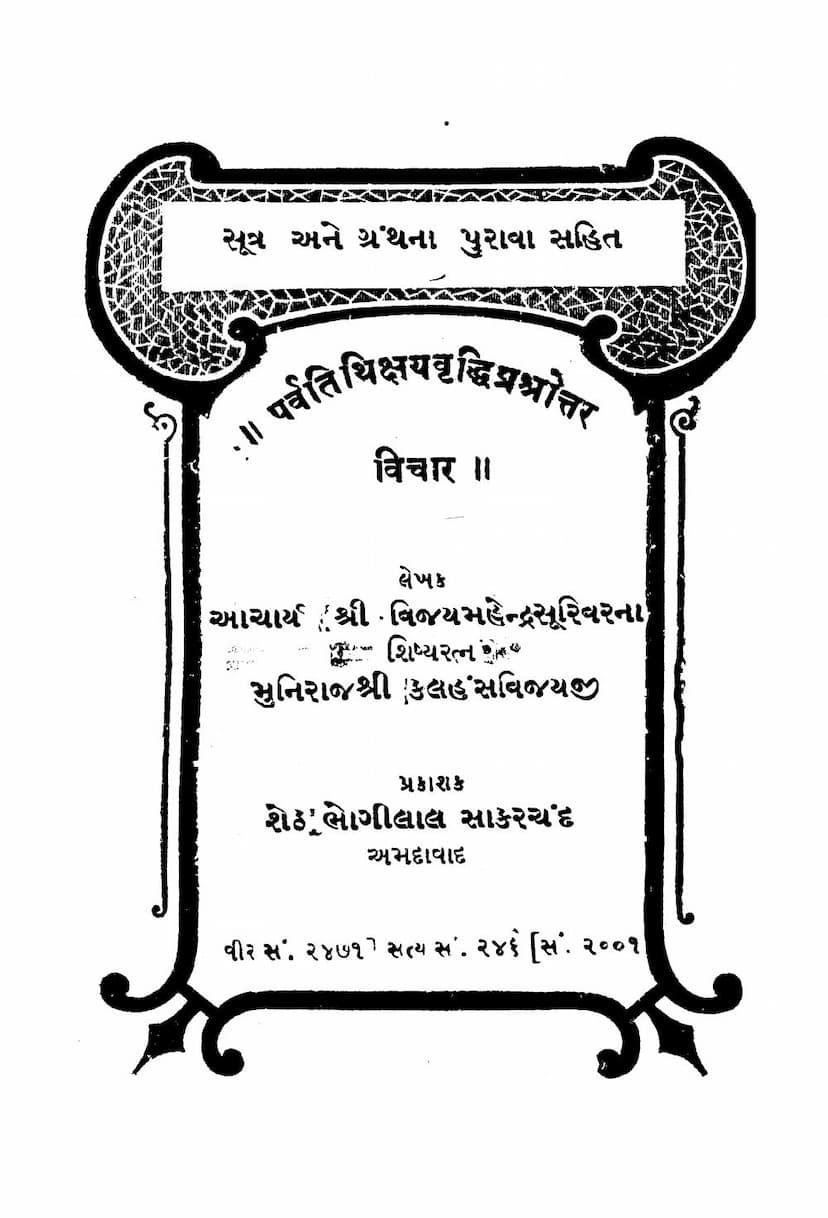Parv Tithi Kshay Vruddhi Prashnottar Vichar
Added to library: September 2, 2025

Summary
This Jain text, "Parv Tithi Kshay Vruddhi Prashnottar Vichar" (Discussion on Festival Dates: Increase and Decrease, Question and Answer) by Muni Shri Kalahansvijayji, addresses a contentious issue within Jainism regarding the observance of festival dates (Tithis) when there are apparent "increases" (Vruddhi) or "decreases" (Kshay) in the lunar calendar. The book was published by Sheth Bhogilal Sakarchand.
The core of the text is a series of questions and answers that aim to clarify and defend the traditional "Shasan Paksha" (observance according to established Jain scriptures and traditions) against the "Nava Panth" (New Path or sect) that deviates from these established norms.
Here's a breakdown of the key points:
The Controversy:
- The Issue: The main disagreement arises when a festival date (Parva Tithi) appears to be present for two consecutive days in the almanac (Panchang). This is called "Vruddhi" (increase). Conversely, when a festival date is missing for a day, it's called "Kshay" (decrease).
- The "Nava Panth" View: This sect believes in aligning with the secular almanac (Laukik Panchang) and argues that if the almanac shows an increase or decrease in a festival date, they should follow it. This leads to observing a festival on a date different from the traditional calculation. For instance, they might observe a festival on the first of the two possible dates, or if a date is missing, they might merge it with the preceding or succeeding date.
- The "Shasan Paksha" View: This traditional view, supported by Jain scriptures (Agamas) and the lineage of Acharyas, states that festival dates themselves do not increase or decrease. Instead, when the secular almanac shows an increase or decrease in a festival date, the non-festival dates (Apva Tithi) that precede or follow it are adjusted. For example, if there's an increase in a festival date, the preceding non-festival date is considered the festival date. If there's a decrease, the non-festival date before the missing festival date is adjusted to accommodate the festival.
Scriptural Basis and Arguments:
- Origin of Tithis: The text cites scriptures like Surya Prajnapti, Chandra Prajnapti, and Jyotishkarandak Sutra to establish that Tithis are generated by the moon's movement. The precise measurement of a Tithi in these scriptures indicates that it is slightly less than a full day (24 hours), thus explaining why Tithis do not always align perfectly with sunrise-to-sunrise days. This inherent measurement means Tithis naturally undergo "Kshay" (decrease) over time, rather than "Vruddhi" (increase).
- Key Festival Dates: The Bhagavati Sutra is quoted to highlight Ashtami (8th day of the lunar fortnight), Chaturdashi (14th day), Amavasya (new moon), and Purnima (full moon) as principal festival dates.
- No Increase or Decrease of Festival Dates: Several passages are quoted from texts like Tapagachha's Brihat Samachari and the works of Acharya Umaswati, explicitly stating that festival dates (Parva Tithi) do not experience increase or decrease.
- How to Handle Kshay/Vruddhi:
- Kshay (Decrease): If a festival date experiences "Kshay" in the almanac, the preceding non-festival date should be observed as the festival date. For example, if Ashtami is missing, the seventh day (Saptami) should be observed as Ashtami.
- Vruddhi (Increase): If a festival date experiences "Vruddhi" (appears on two consecutive days), the second day of the two is considered the true festival date, and the first day is treated as a non-festival date. For instance, if Chaturdashi appears on two days, the second Chaturdashi should be observed.
- The Case of Annual Festival (Samvatsarik Parva): The text specifically addresses the Samvatsarik Parva, which typically marks the end of the monsoon retreat. It cites Acharya Kalikasurishwarji's practice, influenced by King Shalivahana, to observe the festival one day before the fifth day of Bhadrapada (Shukla Paksha) if the almanac shows two fifths. This adherence to tradition is contrasted with the "Nava Panth" tendency to follow the almanac directly, which would lead to observing it on the first of the two fifths, thus deviating from the established practice.
- The Importance of Sunrise (Uday): The text emphasizes that for observances, the Tithi present at sunrise is considered valid. This principle guides how to handle Kshay and Vruddhi to maintain the integrity of the Tithi's religious significance.
- The Danger of Utsootra-Pravaroopana (False Teachings): A significant portion of the book warns against uttering teachings contrary to the scriptures. It highlights that such deviations are considered a grave sin that leads to further rounds of birth and death. The text quotes various Acharyas and saints, including Anandghanji Maharaj, to underscore the importance of adhering strictly to the Jinagam (Jain scriptures) as the sole source of truth and guidance.
Conclusion:
The book strongly advocates for adhering to the scriptural basis and traditional practices of Jainism concerning the observance of festival dates. It argues that the "Nava Panth's" adoption of secular almanac variations for festival observance is a departure from established tradition and scripture, leading to "Utsootra-Pravaroopana" (false teachings). The author urges readers to recognize the importance of following the Agamas and the practices of the Puraacharya (ancient Acharyas) to ensure correct spiritual practice and personal salvation. The text serves as a defense of the "Shasan Paksha" in the face of evolving interpretations of the calendar.